Darts
Darts is a sport in which two or more players throw small missiles, also known as darts, at a circular target, known as a "dartboard".[2]. Points can be scored by hitting specific marked areas of the board, though, unlike in sports such as archery, these areas are distributed all across the board and do not follow a principle of points increasing towards the centre of the board. Though a number of similar games using various boards and rules exist, the term "darts" usually now refers to a standardised game involving a specific board design and set of rules.
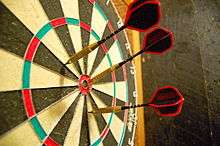 Darts in a dartboard | |
| Highest governing body | WDF |
|---|---|
| Nicknames | throwers, arrows, tungsten, dartsmith |
| First played | approx 1860s United Kingdom [1] |
| Registered players | 655 WDF ranked players 679 PDPA ranked players |
| Characteristics | |
| Team members | Team events exist, see World Cup and PDC World Cup of Darts |
| Mixed gender | Separate men's & women's championship although no restrictions on women competing against men. |
| Type | Target sports, Individual sport |
| Equipment | Set of 3 darts, dartboard |
| Glossary | Glossary of darts |
As well as being a professional competitive sport, darts is a traditional pub game. Darts is commonly played in the United Kingdom and the Republic of Ireland; it is, however, enjoyed across the world.
History
Dartboard
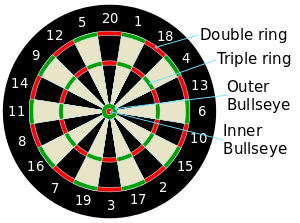
The original target in the game is likely to have been a section of a tree trunk, its circular shape and concentric rings giving rise to the standard dartboard pattern in use today. An older name for a dartboard is "butt"; the word comes from the French word but, meaning "target" or "goal"[3].
The standard numbered point system is attributed to Lancashire carpenter Brian Gamlin, who devised it in 1896 to penalise inaccuracy,[4][5] though this is disputed.[6][7] Many configurations have been used, varying by time and location. In particular, the Yorkshire and Manchester Log End boards differ from the standard board in that they have no triple, only double and bullseye. The Manchester board is smaller than the standard, with a playing area of only 25 cm (9.8 in) across, with double and bull areas measuring just 4 mm (0.16 in). The London Fives board is another variation, with only 12 equal segments, with the doubles and trebles being a quarter of an inch (6.35 mm) wide.
Mathematically, removing the rotational symmetry by placing the "20" at the top, there are 19!, or 121,645,100,408,832,000 possible dartboards. Many different layouts would penalise a player more than the current setup; however, the current setup actually does the job rather efficiently. There have been several mathematical papers published that consider the "optimal" dartboard.[8]
Before World War I, pubs in the United Kingdom had dartboards made from solid blocks of wood, usually elm.[9][10] But darts pocked the surface of elm such that it was common for a hole to develop around the treble twenty. The other problem was that elm wood needed periodic soaking to keep the wood soft.[11]
In 1935, chemist Ted Leggatt and pub owner Frank Dabbs began using the century plant, a type of agave, to make dartboards.[12] Small bundles of sisal fibres of the same length were bundled together. The bundles were then compressed into a disk and bound with a metal ring. This new dartboard was an instant success. It was more durable and required little maintenance. Furthermore, darts did little or no damage to the board; they simply parted the packed fibres when they entered the board.
Darts
The earliest darts were stubs of arrows or crossbow bolts.[13] The first purpose-made darts were manufactured from solid wood, wrapped with a strip of lead for weight and fitted with flights made from split turkey feathers. These darts were mainly produced in France and became known as French darts.[14] Metal barrels were patented in 1906, but wood continued to be used into the 1950s.[13][15]
The first metal barrels were made from brass which was relatively cheap and easy to work.[14] The wooden shafts, threaded to fit the tapped barrel, were either fletched as before or designed to take a paper flight. This type of dart continued to be used into the 1970s.[14] With the widespread use of plastic, the shaft and flight came to be manufactured separately, although one-piece moulded plastic shaft and flight darts were also available.[16]
Equipment
Dartboard
According to the Darts Regulation Authority, a regulation board is 451 mm (17 3⁄4 in) in diameter and is divided into 20 radial sections.[17] Each section is separated with metal wire or a thin band of sheet metal.[18]
Quality dartboards are still made of sisal fibres from East Africa, Brazil, or China; less expensive boards are sometimes made of cork or coiled paper.[19]

Darts
Modern darts have four parts: the points, the barrels, the shafts and the flights.[20]
The points come in two common lengths, 32 and 41 mm (1 1⁄4 and 1 5⁄8 in) and are sometimes knurled or coated to improve players' grip. Others are designed to retract slightly on impact to lessen the chance of the dart bouncing out.[21]
The barrels come in a variety of weights and are usually constructed from brass, silver-nickel, or a tungsten alloy. Brass is cheap but light and therefore brass barrels tend to be very bulky. Tungsten, on the other hand, is twice as dense as brass; thus a tungsten barrel of equivalent weight could be thirty percent smaller in diameter than a brass one.[22] Pure tungsten is very brittle, however, so an alloy is commonly used, with between 80 to 95 percent tungsten and the remainder usually nickel, iron, or copper.[22] Silver-nickel darts offer a compromise between density and cost. Barrels come in three basic shapes: cylindrical, ton, or torpedo.
- Cylindrical barrels are the same diameter along their entire length and so tend to be long and thin. Their slenderness makes them better for grouping, but because they are long, the centre of gravity is further back.
- Ton-shaped barrels are thin at either end and bulge in the middle. This makes them fatter than a cylindrical barrel of equivalent weight but the centre of gravity is further forward and so theoretically easier to throw.
- Torpedo-shaped barrels are widest at the pointed end and taper towards the rear. This shape keeps the bulk of the weight as far forward as possible but, like the ton, gives it a larger diameter than the cylinder.
The shafts are manufactured in various lengths, and some are designed to be cut to length. Shafts are generally made from plastics, nylon polymers, or metals such as aluminium and titanium; and can be rigid or flexible. Longer shafts provide greater stability and allow a reduction in flight size which in turn can lead to closer grouping; but, they also shift the weight towards the rear causing the dart to tilt backwards during flight, requiring a harder, faster throw.
The flight stabilizes the dart by producing drag, thus preventing the rear of the dart from overtaking the point.[20] Modern flights are generally made from plastic, nylon, or foil and are available in a range of shapes and sizes. The three most common shapes in order of size are the standard, the kite, and the smaller pear shape. The less surface area, the less stability but larger flights hamper close grouping. Some manufacturers have sought to solve this by making a flight long and thin but this, in turn, creates other problems such as changing the dart's centre of gravity. Generally speaking, a heavier dart will require a larger flight.[20]
The choice of barrel, shaft, and flight will depend a great deal on the individual player's throwing style. For competitive purposes, a dart cannot weigh more than 50 g (1 3⁄4 oz) including the shaft and flight and cannot exceed a total length of 300 mm (11 3⁄4 in).[23][13]
Playing dimensions
The WDF uses the following standards for play:
- Height: the dartboard is hung so that the centre of the bull's eye is 1.73 m (5 ft 8 in) from the floor. This is considered eye-level for a six-foot person.
- Distance: the oche (line behind which the thrower must stand) should be 2.37 m (7 ft 9 1⁄4 in) from the face of the board. If the face projects outward from the wall, due to the thickness of the board and/or a cabinet in which it is mounted, the oche must be moved back appropriately to maintain the required distance.
The regulations came about due to the United Kingdom and the rest of the world playing at different lengths, with 2.37 m (7 ft 9 1⁄4 in) being the compromise length.[24]
Scoring
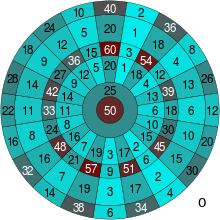
The standard dartboard is divided into 20 numbered sections, scoring from 1 to 20 points, by wires running from the small central circle to the outer circular wire. Circular wires within the outer wire subdivide each section into single, double and triple areas. The dartboard featured on The Indoor League television show of the 1970s did not feature a triple section, and according to host Fred Trueman during the first episode, this is the traditional Yorkshire board.
Various games can be played (and still are played informally) using the standard dartboard. However, in the official game, any dart landing inside the outer wire scores as follows:
- Hitting one of the large portions of each of the numbered sections, traditionally alternately coloured black and white, scores the points value of that section.
- Hitting the thin inner portions of these sections, roughly halfway between the outer wire and the central circle coloured red or green, scores triple the points value of that section.
- Hitting the thin outer portions of these sections, again coloured red or green, scores double the points value of that section. The double-20 is often referred to as double-top, reflecting the 20's position on the dartboard.
- The central circle is divided into a green outer ring worth 25 points (known as "outer", "outer bull", or "single bull") and a red or black inner circle (usually known as "bull", "inner bull" or "double bull"), worth 50 points. The term "bullseye" can mean either the whole central part of the board or just the inner red/black section. The term "bull's ring" usually means just the green outer ring. The inner bull counts as a double when doubling in or out.
- Hitting outside the outer wire scores nothing.
- A dart only scores if its point is embedded in or is touching the playing surface. This rule applies to any dart that lands in such a way as to be partially or totally supported by others that have already hit the board.
- When a standard board is used, any dart whose point does not remain in contact with the playing surface until being collected by the player does not score. This includes darts that bounce off the board for any reason, that fall off on their own, or that are dislodged by the impact of later throws. However, when an electronic board is used, fallen/dislodged darts do score as long as their impacts have registered on the board first.
The highest score possible with three darts is 180, commonly known as a "ton 80" (100 points is called a ton), obtained when all three darts land in the triple 20. In the televised game, the referee frequently announces a score of 180 in exuberant style. A "quad" ring appeared briefly between the triple ring and the bull in the 1990s, leading to a potential 240 maximum (three quad-20s), a 210 maximum checkout (Q20-Q20-Bull) and seven dart finishes from a 501 start (five quad-20s, triple-17, bullseye), but was swiftly dropped from professional tournament play after only two years.[25] One make of this board was the Harrows Quadro 240.[26]
Skill level and aiming
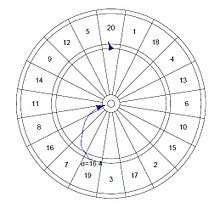
Assuming standard scoring, the optimal area to aim for on the dartboard to maximize the player's score varies significantly based on the player's skill. The skilled player should aim for the centre of the T20, and as the player's skill decreases, their aim moves slightly up and to the left of the T20. At σ = 16.4 mm the best place to aim jumps to the T19. As the player's skill decreases further, the best place to aim curls into the centre of the board, stopping a bit lower than and to the left of the bullseye at σ = 100.[27]
Where σ may refer to the standard deviation for a specific population: List of darts players.
Games
Many games can be played on a dartboard, but the term "darts" generally refers to a game in which one player at a time throws three darts per turn. The throwing player must stand so that no portion of his/her feet extends past the leading edge of the oche, but may stand on any other portion and/or lean forward over it if desired.
A game of darts is generally contested between two players, who take turns. The most common objective is to reduce a fixed score, commonly 301 or 501, to zero ("checking out"). The final dart must land in either the bullseye or a double segment to win. Not all three darts need to be thrown on the final turn, the game can be finished on any of the three darts. When two teams play, the starting score is sometimes increased to 701 or even 1001; the rules remain the same.
A throw that reduces a player's score below zero, to exactly one, or to zero but not ending with a double is known as "going bust", with the player's score being reset to the value before starting the turn, and the remainder of the turn being forfeited.
In some variants (called a "northern bust" in London) only the dart that causes the bust is not counted. That is felt by some to be a purer version of the game, as under the normal rules, as explained above, a player left with a difficult finish, e.g. 5 and one dart remaining will often deliberately "bust" it to get back to the easier finish that they had at the start of their go. For example, a player with 20 at the start of their go could miss the double 10 and get a single, miss the double 5 and get a single, leaving them 5 and only one dart remaining. Their best option is to deliberately bust it to get back onto double 10. Under the "northern bust" they would remain on 5.
A darts match is played over a fixed number of games, known as legs. A match may be divided into sets, with each set being contested as over a fixed number of legs.
Although playing straight down from 501 is standard in darts, sometimes a double must be hit to begin scoring, known as "doubling in", with all darts thrown before hitting a double not being counted. The PDC's World Grand Prix uses this format.
The minimum number of thrown darts required to complete a leg of 501 is nine. The most common nine dart finish consists of two 180 maximums followed by a 141 checkout (T20-T19-D12), but there are many other possible ways of achieving the feat. Three 167s (T20-T19-Bull) is considered a pure or perfect nine-dart finish by some players.
Other games and variants
There are several regional variations on the standard rules and scoring systems.
American darts
American Darts is a regional U.S. variant of the game (most U.S. dart players play the traditional games described above). This style of dartboard is most often found in eastern Pennsylvania, New Jersey, Delaware, Maryland, and parts of New York state.
Cricket
Cricket is a widely played darts game involving a race to control and score on numbers between 20 and 15 and the bullseye, by hitting each of these targets for three marks to open or own it for scoring. A hit on the target counts as one mark, while hits in the doubles ring of the target count as two marks in one throw, and on the triples ring as three. Once opened in this manner, until the opponent closes that number with three marks on it of their own, each additional hit by the owner/opener scores points equal to the number of the target (which may also be doubled and tripled, e.g. a triple-20 is worth 60 points). The outer bullseye counts as 25 points and the inner as 50.
Dartball
Dartball is a darts game based on the sport of baseball. It is played on a diamond-shaped board and has similar scoring to baseball.
Dart golf
Dart golf is a darts game based on the sport of golf and is regulated by the World Dolf Federation (WDFF).[28] It is played on both special golf dartboards and traditional dartboards. Scoring is similar to golf.
Fives
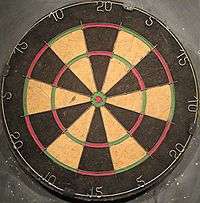
This is a regional variant still played in some parts of the East End of London. The board has fewer, larger segments, all numbered either 5, 10, 15 or 20. Players play down from 505 rather than 501, and stand the farthest (9 ft or 2.7 m) away from the board of any mainstream variation.[29]
Halve it
"Halve it" is a darts game popular in the United Kingdom and parts of North America where competitors try to hit previously agreed targets on a standard dart board.[30] Failure to do so within a single throw (3 darts) results in the player losing half their accumulated score. Any number of players can take part and the game can vary in length depending on the number of targets selected.[31] The game can be tailored to the skill level of the players by selecting easy or difficult targets.
Killer
"Killer" is a 'knock-out' game for two or more players (at its best at 4–6 players). Initially, each player throws a dart at the board with their non-dominant hand to obtain their 'number'. No two players can have the same number. Once everyone has a number, each player takes it in turn to get their number five times with their three darts (doubles count twice, and triples three times). Once a person has reached 5, they become a 'killer'. This means they can aim for other peoples numbers, taking a point off for each time they hit (doubles x2, triples x3). If a person gets to zero they are out. A killer can aim for anyone's numbers, even another killer's. Players cannot get more than 5 points. The winner is 'the last man standing'.[32]
Another version of "Killer" is a "knock-out" game for three or more players (the more the better). To start, everyone has a pre-determined number of lives, (usually 5) and a randomly chosen player throws a single dart at the board to set a target (i.e. single 18) and does not play until that target is hit. The next player up has 3 darts to try and hit the target (single 18), if they fail, they lose a life and the following player tries. Once a player succeeds at hitting the target, they then become the target setter and throw a dart to set a new target. The initial target setter swaps places with the new target setter. The games carries on until every players' lives have been used, the last man standing is the target setter whose target was not hit. For less experienced players you can count doubles and trebles as part of the same number, i.e. a target of treble 20 can still be counted as a success if the double or single 20 is hit and vice versa.
Lawn darts
Lawn darts (also called Jarts or yard darts) is a lawn game based on darts. The gameplay and objective are similar to both horseshoes and darts. The darts are similar to the ancient Roman plumbata.
Round the Clock
Round the Clock (also called Around the World, 20 to 1, and Jumpers)[33] is a game involving any number of players where the objective is to hit each section sequentially from 1 to 20 starting after a starting double.[34]
Shanghai
Shanghai is played with at least two players. The standard version is played in seven rounds.[35] In round one players throw their darts aiming for the 1 section, round 2, the 2 sections and so on until round 7. Standard scoring is used, and doubles and triples are counted. Only hits on the wedge for that round are counted. The winner is the person who has the most points at the end of seven rounds (1–7); or who scores a Shanghai, which wins win instantly, a Shanghai being throws that hit a triple, a double and single (in any order) of the number that is in play.[35]
Shanghai can also be played for 20 rounds to use all numbers. A Fairer Start for Shanghai: To prevent players from becoming too practised at shooting for the 1, the number sequence can begin at the number of the dart that lost the throw for the bullseye to determine the starting thrower. For example; Thrower A shoots for the bullseye and hits the 17. Thrower B shoots for the bullseye and hits it. Thrower B then begins the game, starting on the number 17, then 18, 19, 20, 1, 2, 3, etc. through 16 (if no player hits Shanghai).
Darts organisations
Professional organisations
Of the two professional steel-tip organisations, the British Darts Organisation (BDO), founded in 1973, is the older. Its tournaments were often shown on the BBC in the UK. The BDO is a member of the World Darts Federation (WDF) (founded 1976), along with organizations in some 60 other countries worldwide. The BDO originally organised a number of the more prestigious British tournaments with a few notable exceptions such as the News of the World Championship and the national events run under the auspices of the National Darts Association of Great Britain. However, many sponsors were lost and British TV coverage became much reduced by the early nineties. As of 24 September 2016, the BBC no longer broadcasts the BDO World Championship.
In 1992, a group of darts players broke off from the BDO and, in pursuit of higher prize money, formed the Professional Darts Corporation (PDC). Like the BDO, the PDC organises their tournaments as well as their world championship.
In soft-tip, the World Soft Darts Association serves as a governing body of the sport, with events feature players that play also steel-tip in PDC and BDO events and other players that compete exclusively in soft-tip events.
Amateur league organisations
The American Darts Organization promulgates rules and standards for amateur league darts and sanctions tournaments in the United States. The American Darts Organization began operation January 1, 1976, with 30 charter member clubs and a membership of 7,500 players. Today, the ADO has a membership that averages 250 clubs yearly representing roughly 50,000 members.[36]
Professional play
Since the end of the News of the World Darts Championship and other past major tournaments The BDO and PDC both organise a televised World Professional Championship. They are held annually over the Christmas/New Year period, with the PDC championship finishing slightly earlier than the BDO tournament. The BDO World Championship has been running since 1978; the PDC World Championship started in 1994.
Both organisations hold other professional tournaments. The BDO organise the World Masters and many Open tournaments. They also organise county darts for their 66 county members in the UK including individual and team events.
The PDC's major tournaments are the World Championship, Premier League, UK Open, World Matchplay, World Grand Prix and the Grand Slam of Darts. All of these are broadcast live on Sky Sports television in the UK. They also hold PDC Pro Tour events and smaller category events around the UK.
Two Dutch independently organised major tournaments, the International Darts League and the World Darts Trophy introduced a mix of BDO and PDC players in 2006 and 2007. Both organisations allocated rankings to the tournaments, but these two events are now discontinued.
The WDF World Cup for national teams and a singles tournament has been played biennially since 1977. The WDF also organise the Europe Cup. The PDC has their world cup competition, the PDC World Cup of Darts.
For soft-tip darts, WSDA and DARTSLIVE run THE WORLD, an international tour which serves as the Soft Darts World Championship, with the final tournament referred to as the Grand Final, with the circuit first taking place in 2011. Stages take place mostly in East Asia, with some rounds held in the United States and Europe. Matches during WSDA events are played with both 701 and Cricket during a set, usually with the same number of games of each, giving both players throws during both formats, and the final round determined by player choice.[37]
Professional darts players
World Champions
Multiple-Time World Champions
- 16 Phil Taylor The Power (2 BDO, 14 PDC)
- 10 Trina Gulliver The Golden Girl
- 5 Eric Bristow The Crafty Cockney
- 5 Raymond van Barneveld Barney (4 BDO, 1 PDC)
- 4 Lisa Ashton The Lancashire Rose
- 3 Martin Adams Wolfie
- 3 Anastasia Dobromyslova From Russia With Love
- 3 Glen Durrant Duzza
- 3 John Lowe Old Stoneface
- 3 John Part Darth Maple (1 BDO, 2 PDC)
- 3 Michael van Gerwen Mighty Mike
- 2 Gary Anderson The Flying Scotsman
- 2 Ted Hankey The Count
- 2 Adrian Lewis Jackpot
- 2 Dennis Priestley The Menace (1 BDO, 1 PDC)
- 2 Mikuru Suzuki Miracle
- 2 Scott Waites Scotty 2 Hotty
- 2 Jocky Wilson Jocky
One-Time World Champions
- Bob Anderson The Limestone Cowboy
- Steve Beaton The Bronze Adonis
- Stacy Bromberg The Wish Granter
- Stephen Bunting The Bullet
- Richie Burnett The Prince of Wales
- Rob Cross Voltage
- Tony David The Deadly Boomerang
- Keith Deller The Fella
- Andy Fordham The Viking
- Francis Hoenselaar The Crown
- Christian Kist The Lipstick
- Jelle Klaasen The Cobra
- Scott Mitchell Scotty Dog
- Leighton Rees Marathon Man
- Les Wallace McDanger
- John Walton John Boy
- Wayne Warren Yank
- Mark Webster The Spider
- Peter Wright Snakebite
World rankings
The WDF, BDO and PDC each maintain their own rankings lists. These lists are commonly used to determine seedings for various tournaments. The WDF rankings are based on the preceding 12 months performances, the BDO resets all ranking points to zero after the seedings for their world championship have been determined, and the PDC Order of Merit is based on prize money earned over two years.
See also
- Darts world rankings—current ranking lists for BDO and PDC
- Darts tournaments—previous winners, history and information
- Darts players profiles
- Nine dart finish—the "perfect" game in darts
- High dart average—average score achieved with all three darts thrown
- Glossary of darts
- Pub games
- Bullseye—a British game show based on darts
References
- Masters, Youtham Joseph. "Darts history". Trad games. Archived from the original on 14 June 2009. Retrieved 1 November 2009.
- "Darts". The Free Dictionary. Archived from the original on 4 January 2011. Retrieved 21 August 2010.
- "Google Translate". translate.google.co.uk. Retrieved 2020-07-26.
- Darts History Archived 2016-01-03 at the Wayback Machine - Darts Info World
- Eiselt, H; Laporte, Gilbert (February 1991). "A Combinatorial Optimization Problem Arising in Dartboard Design". The Journal of the Operational Research Society. Palgrave Macmillan Journals. 42 (2): 113–118. doi:10.2307/2583175. JSTOR 2583175.
- "Darts 501 - Brian Gamlin Dartboard Numbers". Archived from the original on 2016-03-06. Retrieved 2016-02-29.
- "Darts - History and information on Dartboards and darts". Archived from the original on 2009-06-14. Retrieved 2004-02-17.
- See, for example:
- K. Selkirk (1976), "Redesigning the dartboard", Mathematical Gazette, vol. 60, pages 171–178
- P. J. Everson and A. P. Bassom (January 1995). "Optimal arrangements for a dartboard", Mathematical Spectrum, vol. 27, no. 2, pages 32–34
- Eiselt, H; Laporte, Gilbert (February 1991). "A Combinatorial Optimization Problem Arising in Dartboard Design". The Journal of the Operational Research Society. Palgrave Macmillan Journals. 42 (2): 113–118. doi:10.2307/2583175. JSTOR 2583175.
- Ivars Peterson (May 19, 1997). "Around the dartboard"
- G. L. Cohen and E. Tonkes (2001) "Dartboard arrangements" Archived 2011-06-28 at the Wayback Machine, The Electronic Journal of Combinatorics, vol. 8, no. 2, pages 4
- Ryan J. Tibshirani, Andrew Price, and Jonathan Taylor (January 2011) "A statistician plays darts" Archived 2011-07-20 at the Wayback Machine, Journal of the Royal Statistical Society, series A, vol. 174, no. 1, pages 213–226.
Article on the preceding article: Cameron Bird (Dec. 2009) "Darts for geeks: Statistician cracks the game's secrets" Archived 2014-03-16 at the Wayback Machine, Wired. - Trevor Lipscombe and Arturo Sangalli (2001) "The Devil's Dartboard", Crux Mathematicorum, vol. 27, no. 4, pages 215–21.
- David F. Percy (Dec. 2012) "The Optimal Dartboard?", Mathematics TODAY, Dec. 2012, pages 268–270.
- "The Nodor - Winmau Story". PatrickChaplin. 2019-05-22. Archived from the original on 4 November 2019. Retrieved 4 November 2019.
- "The history of darts". TalkDarts. Archived from the original on 8 June 2017. Retrieved 25 December 2014.
- "How to Maintain Your Darts and Dart Board". Above House. 10 December 2019. Retrieved 16 March 2020.
- Lotowycz, Randall; Passineau, John (2013). The Mini Book of Mini Darts. Workman Publishing Company. p. 29. ISBN 978-0761177432.
- "History of Darts from Harrows, UK". Harrows. Archived from the original on 2 April 2015. Retrieved 25 December 2014.
- "The History of the Dart". 2007. Patrick Chaplin. 2019-05-21. Archived from the original on 4 November 2019. Retrieved 4 November 2019.
- "History of Darts from Harrows, UK". Harrows. Archived from the original on 5 August 2012. Retrieved 12 November 2011.
- "Moulded plastic flights". Dart Dealer. Archived from the original on 25 April 2012. Retrieved 12 November 2011.
- "Darts Regulation Authority Rule Book" (PDF). www.thedra.co.uk. 11 January 2019. Archived (PDF) from the original on 25 January 2019. Retrieved 6 March 2019.
- "British Darts Organisation Officially Website". BDO darts. 1 April 2006. Retrieved 19 May 2015.
- "How Do You Play Killer In Darts". Blogspot. 10 December 2017. Retrieved 2020-03-14.
- "About darts". dartsinfoworld.com. Archived from the original on 31 October 2011. Retrieved 12 November 2011.
- "Selecting the Right Darts". Thebro.zone. Archived from the original on 2018-11-04. Retrieved 2018-11-04.
- "Tungsten Technology". Harrows Darts. Archived from the original on 12 February 2012. Retrieved 12 November 2011.
- "Dart Weights and How to Choose". triplebullseye. 2019-12-10. Archived from the original on 2018-12-18. Retrieved 2018-12-18.
- "World Darts Federation Playing and Tournament Rules Twentieth Revised Edition" (PDF). www.dartswdf.com. 28 February 2018. Retrieved 4 March 2019.
- Jocky Wilson Only 240 Ever Seen vs John Lowe Skol World Matchplay. YouTube. 16 November 2013. Archived from the original on 18 December 2015. Retrieved 22 August 2014.
- Tim Cronian. "QUADRO Dartboard". crowsdarts.com. Archived from the original on 2015-02-23. Retrieved 2014-10-26.
- Ryan J. Tibshirani, Andrew Price, and Jonathan Taylor (January 2011) "A statistician plays darts" Archived 2011-07-20 at the Wayback Machine, Journal of the Royal Statistical Society, series A, vol. 174, no. 1, pages 213–226
- "History of Dolf" http://www.dolfdarts.com/history-of-dolf Archived 2012-03-15 at the Wayback Machine
- East London Advertiser Fives still alive in darts
- "Dart games - Halve it". Diddle for the Middle. Archived from the original on 3 September 2011. Retrieved 14 November 2011.
- "General rules for 'Halve it'". Darts 501. Archived from the original on 5 December 2011. Retrieved 14 November 2011.
- "Board of brilliant versatility". BBC Sport. 29 December 2003. Archived from the original on 14 July 2007. Retrieved 2010-08-24.
- Bangkok Jumpers League Archived 2007-10-12 at the Wayback Machine Bangkok Jumpers League
- Augustyn, Adam (16 January 2016). "Darts". Britannica. Archived from the original on 11 May 2016. Retrieved 4 March 2019.
- "Archived copy". Archived from the original on 2009-07-06. Retrieved 2009-07-16.CS1 maint: archived copy as title (link) Dart Games: Shanghai
- "American Darts Organization Official Website". ADO darts. 23 February 2011. Archived from the original on 25 December 2014. Retrieved 25 December 2014.
- "THE WORLD". THE WORLD. Archived from the original on 2017-01-05. Retrieved 2019-01-15.
Further reading
- Chaplin, Patrick (2010), Darts in England, 1900–39: A Social History, Manchester: Manchester University Press, distributed by Palgrave Macmillan, ISBN 978-0-7190-7803-3. Scholarly history showing how darts figured in publicans' efforts to improve their establishments, and how the sport moved from a working-class pursuit to gain middle- and upper-class players.
External links
| Wikimedia Commons has media related to Darts. |
| Wikinews has news related to: |
| Wikiquote has quotations related to: Darts |